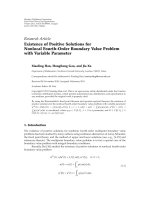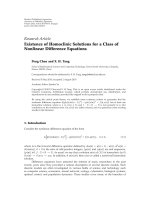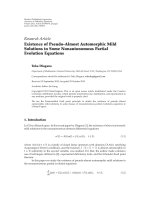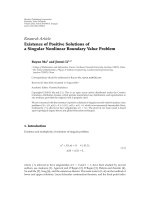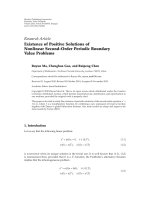Báo cáo hoa học: " Research Article Existence of Solutions for m-point Boundary Value Problems on a Half-Line" potx
Bạn đang xem bản rút gọn của tài liệu. Xem và tải ngay bản đầy đủ của tài liệu tại đây (505.07 KB, 11 trang )
Hindawi Publishing Corporation
Advances in Difference Equations
Volume 2009, Article ID 609143, 11 pages
doi:10.1155/2009/609143
Research Article
Existence of Solutions for m-point Boundary Value
Problems on a Half-Line
Changlong Yu, Yanping Guo, and Yude Ji
College of Sciences, Hebei University of Science and Technology, Shijiazhuang 050018, Hebei, China
Correspondence should be addressed to Changlong Yu,
Received 5 April 2009; Accepted 6 July 2009
Recommended by Paul Eloe
By using the Leray-Schauder continuation theorem, we establish the existence of solutions for
m-point boundary value problems on a half-line x
tft, xt,x
t 0, 0 <t<∞,x0
m−2
i1
α
i
xη
i
, lim
t → ∞
x
t0, where α
i
∈ R,
m−2
i1
α
i
/
1and0<η
1
<η
2
< ··· <η
m−2
< ∞ are
given.
Copyright q 2009 Changlong Yu et al. This is an open access article distributed under the Creative
Commons Attribution License, which permits unrestricted use, distribution, and reproduction in
any medium, provided the original work is properly cited.
1. Introduction
Multipoint boundary value problems BVPs for second-order differential equations in a
finite interval have been studied extensively and many results for the existence of solutions,
positive solutions, multiple solutions are obtained by use of the Leray-Schauder continuation
theorem, Guo-Krasnosel’skii fixed point theorem, and so on; for details see 1–4 and the
references therein.
In the last several years, boundary value problems in an infinite interval have been
arisen in many applications and received much attention; see 5, 6. Due to the fact that
an infinite interval is noncompact, the discussion about BVPs on the half-line is more
complicated, see 5–14 and the references therein. Recently, in 15, Lian and Ge studied
the following three-point boundary value problem:
x
t
f
t, x
t
,x
t
0, 0 <t<∞,
x
0
αx
η
, lim
t → ∞
x
t
0,
1.1
2 Advances in Difference Equations
where α ∈ R, α
/
1, and η ∈ 0, ∞ are given. In this paper, we will study the following
m-point boundary value problems:
x
t
f
t, x
t
,x
t
0, 0 <t<∞,
x
0
m−2
i1
α
i
x
η
i
, lim
t → ∞
x
t
0,
1.2
where α
i
∈ R,
m−2
i1
α
i
/
1,α
i
have the same signal, and 0 <η
1
<η
2
< ··· <η
m−2
< ∞ are
given. We first present the Green function for second-order multipoint BVPs on the half-line
and then give the existence results for 1.2 using the properties of this Green function and
the Leray-Schauder continuation theorem.
We use the space C
1
∞
0, ∞{x ∈ C
1
0, ∞, lim
t → ∞
xt exists, lim
t → ∞
x
t exists}
with the norm x max{x
∞
, x
∞
}, where ·
∞
is supremum norm on the half-line, and
L
1
0, ∞{x : 0, ∞ → R is absolutely integrable on 0, ∞} with the norm x
L
1
∞
0
|xt|dt.
We set
P
∞
0
p
s
ds, P
1
∞
0
sp
s
ds, Q
∞
0
q
s
dt,
1.3
and we suppose α
i
,i 1, 2, ,m− 2 are the same signal in this paper and we always assume
α
m−2
i1
α
i
.
2. Preliminary Results
In this section, we present some definitions and lemmas, which will be needed in the proof
of the main results.
Definition 2.1 see 15. It holds that f : 0, ∞ × R
2
−→ R is called an S-Carath
´
eodory
function if and only if
i for each u, v ∈ R
2
,t→ ft, u, v is measurable on 0, ∞,
ii for almost every t ∈ 0, ∞, u, v → ft, u, v is continuous on R
2
,
iii for each r>0, there exists ϕ
r
t ∈ L
1
0, ∞ with tϕ
r
t ∈ L
1
0, ∞,ϕ
r
t > 0on
0, ∞ such that max{|u|, |v|} ≤ r implies |ft, u, v|≤ϕ
r
t, for a.e. t ∈ 0, ∞.
Lemma 2.2. Suppose
m−2
i1
α
i
/
1, if for any vt ∈ L
1
0, ∞ with tvt ∈ L
1
0, ∞, then the
BVP,
x
t
v
t
0, 0 <t<∞,
x
0
m−2
i1
α
i
x
η
i
, lim
t → ∞
x
t
0,
2.1
Advances in Difference Equations 3
has a unique solution. Moreover, this unique solution can be expressed in the form
x
t
∞
0
G
t, s
v
s
ds, 2.2
where Gt, s is defined by
G
t, s
1
Λ
⎧
⎪
⎪
⎪
⎪
⎪
⎪
⎪
⎪
⎪
⎪
⎪
⎪
⎪
⎪
⎪
⎪
⎪
⎪
⎪
⎪
⎪
⎪
⎪
⎪
⎪
⎪
⎪
⎪
⎨
⎪
⎪
⎪
⎪
⎪
⎪
⎪
⎪
⎪
⎪
⎪
⎪
⎪
⎪
⎪
⎪
⎪
⎪
⎪
⎪
⎪
⎪
⎪
⎪
⎪
⎪
⎪
⎪
⎩
m−2
i1
α
i
s Λs, s ≤ η
1
,s≤ t,
m−2
i1
α
i
s Λt, s ≤ η
1
,t≤ s,
i
k1
α
k
η
k
m−2
ki1
α
k
s Λs, 0 <η
i
≤ s ≤ η
i1
,s≤ t, i 1, 2, ,m− 3,
i
k1
α
k
η
k
m−2
ki1
α
k
s Λt, 0 <η
i
≤ s ≤ η
i1
,t≤ s, i 1, 2, ,m− 3,
m−2
i1
α
i
η
i
Λs, s ≥ η
m−2
,s≤ t,
m−2
i1
α
i
η
i
Λt, s ≥ η
m−2
,t≤ s,
2.3
here note Λ1 −
m−2
i1
α
i
.
Proof. Integrate the differential equation from t to ∞, noticing that vt,tvt ∈ L
1
0, ∞,
then from 0 to t and one has
x
t
x
0
t
0
∞
s
v
τ
dτ ds.
2.4
Since x0
m−2
i1
α
i
xη
i
,from2.4, it holds that
x
t
1
1 −
m−2
i1
α
i
m−2
i1
α
i
η
i
∞
η
i
v
s
ds
m−2
i1
α
i
η
i
0
sv
s
ds
t
∞
t
v
s
ds
t
0
sv
s
ds.
2.5
For 0 ≤ t ≤ η
1
, the unique solution of 2.1 can be stated by
x
t
t
0
m−2
i1
α
i
s
1 −
m−2
i1
α
i
s
v
s
ds
η
1
t
m−2
i1
α
i
s
1 −
m−2
i1
α
i
t
v
s
ds
m−3
i1
η
i1
η
i
i
k1
α
k
η
k
m−2
ki1
α
k
s Λt
1 −
m−2
i1
α
i
v
s
ds
∞
η
m−2
m−2
i1
α
i
η
i
1 −
m−2
i1
α
i
t
v
s
ds.
2.6
4 Advances in Difference Equations
If η
i
≤ t ≤ η
i1
, 1 ≤ i ≤ m − 3, the unique solution of 2.1 can be stated by
x
t
η
1
0
m−2
i1
α
i
s
1 −
m−2
i1
α
i
s
v
s
ds
i−1
j1
η
j1
η
j
⎛
⎝
j
k1
α
k
η
k
m−2
kj1
α
k
s Λs
1 −
m−2
i1
α
i
⎞
⎠
v
s
ds
t
η
i
i
k1
α
k
η
k
m−2
ki1
α
k
s Λs
1 −
m−2
i1
α
i
v
s
ds
η
i1
t
i
k1
α
k
η
k
m−2
ki1
α
k
s Λt
1 −
m−2
i1
α
i
v
s
ds
m−3
ji1
η
j1
η
j
⎛
⎝
j
k1
α
k
η
k
m−2
kj1
α
k
s Λt
1 −
m−2
i1
α
i
⎞
⎠
v
s
ds
∞
η
m−2
m−2
i1
α
i
η
i
1 −
m−2
i1
α
i
t
v
s
ds.
2.7
If η
m−2
≤ t<∞, the unique solution of 2.1 can be stated by
x
t
η
1
0
m−2
i1
α
i
s
1 −
m−2
i1
α
i
s
v
s
ds
m−3
i1
η
i1
η
i
i
k1
α
k
η
k
m−2
ki1
α
k
s Λs
1 −
m−2
i1
α
i
v
s
ds
t
η
m−2
m−2
i1
α
i
η
i
1 −
m−2
i1
α
i
s
v
s
ds
∞
t
m−2
i1
α
i
η
i
1 −
m−2
i1
α
i
t
v
s
ds.
2.8
We note Λ1 −
m−2
i1
α
i
, then
G
t, s
1
Λ
⎧
⎪
⎪
⎪
⎪
⎪
⎪
⎪
⎪
⎪
⎪
⎪
⎪
⎪
⎪
⎪
⎪
⎪
⎪
⎪
⎪
⎪
⎪
⎪
⎪
⎪
⎪
⎪
⎨
⎪
⎪
⎪
⎪
⎪
⎪
⎪
⎪
⎪
⎪
⎪
⎪
⎪
⎪
⎪
⎪
⎪
⎪
⎪
⎪
⎪
⎪
⎪
⎪
⎪
⎪
⎪
⎩
m−2
i1
α
i
s Λs, s ≤ η
1
,s≤ t,
m−2
i1
α
i
s Λt, s ≤ η
1
,t≤ s,
i
k1
α
k
η
k
m−2
ki1
α
k
s Λs, 0 <η
i
≤ s ≤ η
i1
,s≤ t, i 1, 2, ,m− 3,
i
k1
α
k
η
k
m−2
ki1
α
k
s Λt, 0 <η
i
≤ s ≤ η
i1
,t≤ s, i 1, 2, ,m− 3,
m−2
i1
α
i
η
i
Λs, s ≥ η
m−2
,s≤ t,
m−2
i1
α
i
η
i
Λt, s ≥ η
m−2
,t≤ s.
2.9
Advances in Difference Equations 5
Therefore, the unique solution of 2.1 is xt
∞
0
Gt, svsds, which completes the
proof.
Remark of Lemma 2.2.Obviously Gt, s satisfies the properties of a Green function, so we call
Gt, s the Green function of the corresponding homogeneous multipoint BVP of 2.1 on the
half-line.
Lemma 2.3. For all t, s ∈ 0, ∞, it holds that
|
G
t, s
|
≤
⎧
⎪
⎪
⎪
⎪
⎪
⎪
⎪
⎪
⎪
⎪
⎨
⎪
⎪
⎪
⎪
⎪
⎪
⎪
⎪
⎪
⎪
⎩
s,
m−2
i1
α
i
< 0,
s
Λ
, 0 ≤
m−2
i1
α
i
< 1,
max
⎧
⎨
⎩
m−2
i1
α
i
s
−Λ
,
m−2
i1
α
i
η
m−2
−Λ
⎫
⎬
⎭
,
m−2
i1
α
i
> 1.
2.10
Proof. For each s ∈ 0, ∞, Gt, s is nondecreasing in t. Immediately, we have
min
m−2
i1
α
i
s
Λ
,
i
k1
α
k
η
k
m−2
ki1
α
k
s
Λ
,
m−2
i1
α
i
η
i
Λ
≤ G
t, s
≤ G
s, s
1
Λ
⎧
⎪
⎪
⎪
⎪
⎪
⎪
⎪
⎪
⎨
⎪
⎪
⎪
⎪
⎪
⎪
⎪
⎪
⎩
s, s ≤ η
1
,
i
k1
α
k
η
k
m−2
ki1
α
k
Λ
s, η
i
≤ s ≤ η
i1
< ∞,i 1, 2, ,m− 3,
m−2
i1
α
i
η
i
Λs, s ≥ η
m−2
.
2.11
Further, we have
m−2
i1
α
i
s
Λ
≤ G
t, s
≤ s,
m−2
i1
α
i
< 0,
0 < min
m−2
i1
α
i
s
Λ
,
m−2
i1
α
i
η
1
Λ
≤ G
t, s
≤
s
Λ
, 0 ≤
m−2
i1
α
i
< 1,
min
m−2
i1
α
i
s
Λ
,
m−2
i1
α
i
η
m−2
Λ
≤ G
t, s
≤ s,
m−2
i1
α
i
> 1.
2.12
Therefore, we get the result.
6 Advances in Difference Equations
Lemma 2.4. For the Green function Gt, s, it holds that
lim
t → ∞
G
t, s
G
s
1
Λ
⎧
⎪
⎪
⎪
⎪
⎪
⎪
⎪
⎪
⎪
⎨
⎪
⎪
⎪
⎪
⎪
⎪
⎪
⎪
⎪
⎩
s, s ≤ η
1
,
i
k1
α
k
η
k
m−2
ki1
α
k
Λ
s, η
i
≤ s ≤ η
i1
< ∞,i 1, 2, ,m− 3
m−2
i1
α
i
η
i
Λs, s ≥ η
m−2
.
2.13
Lemma 2.5. For the function x ∈ C
1
0, ∞, it is satisfied that
x
0
m−2
i1
α
i
x
η
i
2.14
and α
i
i 1, 2, ,m− 2 have the same signal, 0 <η
1
<η
2
< ··· <η
m−2
< ∞, then there exists
η ∈ η
1
,η
m−2
satisfying
x
0
αx
η
, 2.15
where α
m−2
i1
α
i
.
Proof. Let α
i
i 1, 2, ,m− 2 are positive, and note M
∗
max{xt | t ∈ η
1
,η
m−2
},m
∗
min{xt | t ∈ η
1
,η
m−2
}, then for every i i 1, 2, ,m− 2, we have m
∗
≤ xη
i
≤ M
∗
,
so m
∗
m−2
i1
α
i
≤
m−2
i1
α
i
xη
i
≤ M
∗
m−2
i1
α
i
, that is, m
∗
≤
m−2
i1
α
i
xη
i
/
m−2
i1
α
i
x ≤ M
∗
.
Because xt is continuous on the interval η
1
,η
m−2
, there exists η ∈ η
1
,η
m−2
satisfying
x0αxη, where α
m−2
i1
α
i
.
Theorem 2.6 see 5. Let M ⊂ C
∞
0, ∞{x ∈ C0, ∞, lim
t → ∞
xt exists}.ThenM is
relatively compact in X if the following conditions hold:
a M is uniformly bounded in C
∞
0, ∞;
b the functions from M are equicontinuous on any compact interval of 0, ∞;
c the functions from M are equiconvergent, that is, for any given >0,thereexistsaT
T > 0 such that |ft − f∞| <, f or any t>T,f∈ M.
3. Main Results
Consider the space X {x ∈ C
1
∞
0, ∞,x0
m−2
i1
α
i
xη
i
, lim
t → ∞
x
t0} and define
the operator T : X × 0, 1 → X by
T
x, λ
t
λ
∞
0
G
t, s
f
s, x
s
,x
s
ds, 0 ≤ t<∞. 3.1
The main result of this paper is following.
Advances in Difference Equations 7
Theorem 3.1. Let f : 0, ∞ × R
2
→ R be an S-Carath
´
eodory function. Suppose further that there
exists functions pt,qtrt ∈ L
1
0, ∞ with tpt,tqttrt ∈ L
1
0, ∞ such that
f
t, u, v
≤ p
t
|
u
|
q
t
|
v
|
r
t
3.2
for almost every t ∈ 0, ∞ and all u, v ∈ R
2
.Then1.2 has at least one solution provided:
η
m−2
P P
1
Q<1,α<0,
αη
m−2
1 − α
P P
1
Q<1, 0 ≤ α<1,
max
αη
m−2
α − 1
P P
1
Q,
αP
1
α − 1
αη
m−2
P
α − 1
< 1,α>1.
3.3
Lemma 3.2. Let f : 0, ∞ × R
2
→ R be an S-Carath
´
eodory function. Then, for each λ ∈
0, 1,Tx, λ is completely continuous in X.
Proof. First we show T is well defined. Let x ∈ X; then there exists r>0 such that x≤r. For
each λ ∈ 0, 1, it h olds that
T
x, λ
t
λ
∞
0
G
t, s
f
s, x
s
,x
s
ds
≤
∞
0
|
G
t, s
|
ϕ
r
s
ds < ∞, ∀t ∈
0, ∞
.
3.4
Further, Gt, s is continuous in t so the Lebesgue dominated convergence theorem implies
that
|
T
x, λ
t
1
− T
x, λ
t
2
|
≤ λ
∞
0
|
G
t
1
,s
− G
t
2
,s
|
f
s, x
s
,x
s
ds
≤ λ
∞
0
|
G
t
1
,s
− G
t
2
,s
|
ϕ
r
s
ds
−→ 0, as t
1
−→ t
2
,
3.5
T
x, λ
t
1
− T
x, λ
t
2
≤ λ
t
2
t
1
f
s, x
s
,x
s
ds
≤
t
2
t
1
ϕ
r
s
ds −→ 0ast
1
−→ t
2
,
3.6
where 0 ≤ t
1
,t
2
< ∞.Thus,Tx ∈ C
1
0, ∞.
8 Advances in Difference Equations
Obviously, Tx, λ0
m−2
i1
α
i
Tx, λη
i
.Noticethat
lim
t → ∞
T
x, λ
t
lim
t → ∞
∞
t
f
s, x
s
,x
s
ds 0,
3.7
so we can get Tx, λt ∈ X.
We claim that Tx, λ is completely continuous in X, that is, for each λ ∈ 0, 1, Tx, λ
is continuous in X and maps a bounded subset of X into a relatively compact set.
Let x
n
→ x as n → ∞ in X. Next we prove that for each λ ∈ 0, 1, Tx
n
,λ → Tx, λ
as n → ∞ in X. Because f is a S-Carath
´
eodory function and
∞
0
G
s
f
s, x
n
s
,x
n
s
− f
s, x
s
,x
s
ds
≤ 2
∞
0
G
s
ϕ
r
0
s
ds < ∞,
3.8
where r
0
> 0 is a real number such that max{max
n∈N\{0}
x
n
, x} ≤ r
0
, we have
|
T
x
n
,λ
∞
− T
x, λ
∞
|
≤ λ
∞
0
G
s
f
s, x
n
s
,x
n
s
− f
s, x
s
,x
s
ds
−→ 0, as n −→ ∞.
3.9
Also, we can get
|
T
x
n
,λ
t
− T
x
n
,λ
∞
|
≤ λ
∞
0
G
t, s
−
G
s
f
s, x
n
s
,x
n
s
ds
≤
∞
0
G
t, s
−
G
s
ϕ
r
0
s
ds
−→ 0, as t −→ ∞,
3.10
T
x
n
,λ
t
− T
x
n
,λ
∞
≤
∞
t
f
s, x
n
s
,x
n
s
ds
≤
∞
t
ϕ
r
0
s
ds −→ 0, as t −→ ∞.
3.11
Similarly, we have
|
T
x, λ
t
− T
x, λ
∞
|
−→ 0, as t −→ ∞,
T
x, λ
t
− T
x, λ
∞
−→ 0, as t −→ ∞.
3.12
Advances in Difference Equations 9
For any positive number T
0
< ∞, when t ∈ 0,T
0
, we have
|
T
x
n
,λ
t
− T
x, λ
t
|
≤
∞
0
|
G
t, s
|
f
s, x
n
s
,x
n
s
− f
s, x
s
,x
s
ds
−→ 0, as n −→ ∞,
T
x
n
,λ
t
− T
x, λ
t
≤
∞
t
f
s, x
n
s
,x
n
s
− f
s, x
s
,x
s
ds
−→ 0, as n −→ ∞.
3.13
Combining 3.9–3.13, we can see that T·,λ is continuous. Let B ⊂ X be a bounded
subset; it is easy to prove that TB is uniformly bounded. In the same way, we can prove
3.5,3.6,and3.12, we can also show that TB is equicontinuous and equiconvergent. Thus,
by Theorem 2.6, T·,λ : X×0, 1 → X is completely continuous. The proof is completed.
Proof of Theorem 3.1. In view of Lemma 2.2, it is clear that x ∈ X is a solution of the BVP 1.2 if
and only if x is a fixed point of T·, 1. Clearly, Tx, 00 for each x ∈ X. If for each λ ∈ 0, 1
the fixed points T·,λ in X belong to a closed ball of X independent of λ, then the Leray-
Schauder continuation theorem completes the proof. We have known T·,λ is completely
continuous by Lemma 3.2. Next we show that the fixed point of T·,λ has a priori bound M
independently of λ. Assume x T x, λ and set
Q
1
∞
0
sq
s
ds, R
∞
0
r
s
ds, R
1
∞
0
sr
s
dt. 3.14
According to Lemma 2.5, we know that for any x ∈ X, there exists η ∈ η
1
,η
m−2
satisfying
x0αxη. Hence, there are three cases as follow.
Case 1 α<0. For any x ∈ X, x0xη ≤ 0 holds and, therefore, there exists a t
0
∈ 0,η such
that xt
0
0. Then, we have
|
x
t
|
t
t
0
x
s
ds
≤
t η
x
∞
≤
t η
m−2
x
∞
,t∈
0, ∞
, 3.15
and so it holds that
x
∞
≤
λft, x, x
L
1
≤
ft, x, x
L
1
≤
pt|xt| qt|x
t| rt
L
1
≤
η
m−2
P P
1
Q
x
∞
R,
3.16
therefore,
x
∞
≤
R
1 − η
m−2
P − P
1
− Q
M
1
.
3.17
10 Advances in Difference Equations
At the same time, we have
|
x
t
|
≤ λ
∞
0
G
t, s
f
s, x
s
,x
s
ds
≤
∞
0
sf
s, x
s
,x
s
ds
≤ P
1
x
∞
Q
1
M
1
R
1
,t∈
0, ∞
,
3.18
and so
x
∞
≤
Q
1
M
1
R
1
1 − P
1
M
1
.
3.19
Set M max{M
1
,M
1
}, which is independent of λ.
Case 2 0 ≤ α<1. For any x ∈ X, we have
|
x
t
|
αx
η
t
0
x
s
ds
≤ α
x
η
t
x
∞
,t∈
0, ∞
, 3.20
which implies that |xt|≤αη/1 − αtx
∞
≤ αη
m−2
/1 − αtx
∞
for all t ∈ 0, ∞.
In the same way as for Case 1, we can get
x
∞
≤
1 − α
R
1 − α
1 − P
1
− Q
− αη
m−2
P
M
2
,
x
∞
≤
Q
1
M
2
R
1
1 − α − P
1
M
2
.
3.21
Set M max{M
2
,M
2
}, which is independent of λ and is what we need.
Case 3 α>1. For x ∈ X, we have
|
x
t
|
x
η
t
η
x
s
ds
≤
1
α
|
x
0
|
t − η
x
∞
,t∈
0, ∞
, 3.22
and so |xt|≤αη/α − 1tx
∞
≤ αη
m−2
/α − 1tx
∞
for all t ∈ 0, ∞.
Similarly, we obtain
x
∞
≤
α − 1
R
α − 1
1 − P
1
− Q
− αη
m−2
P
M
3
,
x
∞
≤
α
Q
1
M
3
R
1
αη
m−2
QM
3
R
α − 1 − αη
m−2
P
M
3
.
3.23
Set M max{M
3
,M
3
} and which is we need. So 1.2 has at least one solution.
Advances in Difference Equations 11
Acknowledgment
The Natural Science Foundation of Hebei Province A2009000664 and the Foundation of
Hebei University of Science and Technology XL200759 are acknowledged.
References
1 C. P. Gupta, “A note on a second order three-point boundary value problem,” Journal of Mathematical
Analysis and Applications, vol. 186, no. 1, pp. 277–281, 1994.
2 C. P. Gupta and S. I. Trofimchuk, “A sharper condition for the solvability of a three-point second
order boundary value problem,” Journal of Mathematical Analysis and Applications, vol. 205, no. 2, pp.
586–597, 1997.
3 R. Ma, “Positive solutions for second-order three-point boundary value problems,” Applied
Mathematics Letters, vol. 14, no. 1, pp. 1–5, 2001.
4 Y. Guo and W. Ge, “Positive solutions for three-point boundary value problems with dependence on
the first order derivative,” Journal of Mathematical Analysis and Applications, vol. 290, no. 1, pp. 291–301,
2004.
5 D. O’Regan, Theory of Singular Boundary Value Problems, World Scientific, River Edge, NJ, USA, 1994.
6 R. P. Agarwal and D. O’Regan, Infinite Interval Problems for Differential, Difference and Integral Equations,
Kluwer Academic Publishers, Dordrecht, The Netherlands, 2001.
7 J. V. Baxley, “Existence and uniqueness for nonlinear boundary value problems on infinite intervals,”
Journal of Mathematical Analysis and Applications, vol. 147, no. 1, pp. 122–133, 1990.
8 D. Jiang and R. P. Agarwal, “A uniqueness and existence theorem for a singular third-order boundary
value problem on 0, ∞,” Applied Mathematics Letters, vol. 15, no. 4, pp. 445–451, 2002.
9 R. Ma, “Existence of positive solution for second-order boundary value problems on infinite
intervals,” Applied Mathematics Letters, vol. 16, pp. 33–39, 2003.
10 C. Bai and J. Fang, “On positive solutions of boundary value problems for second-order functional
differential equations on infinite intervals,” Journal of Mathematical Analysis and Applications, vol. 282,
no. 2, pp. 711–731, 2003.
11 B. Yan and Y. Liu, “Unbounded solutions of the singular boundary value problems for second order
differential equations on the half-line,” Applied Mathematics and Computation, vol. 147, no. 3, pp. 629–
644, 2004.
12 Y. Tian and W. Ge, “Positive solutions for multi-point boundary value problem on the half-line,”
Journal of Mathematical Analysis and Applications, vol. 325, no. 2, pp. 1339–1349, 2007.
13 Y. Tian, W. Ge, and W. Shan, “Positive solutions for three-point boundary value problem on the half-
line,” Computers & Mathematics with Applications, vol. 53, no. 7, pp. 1029–1039, 2007.
14 M. Zima, “On positive solutions of boundary value problems on the half-line,” Journal of Mathematical
Analysis and Applications, vol. 259, no. 1, pp. 127–136, 2001.
15 H. Lian and W. Ge, “Solvability for second-order three-point boundary value problems on a half-line,”
Applied Mathematics Letters, vol. 19, no. 10, pp. 1000–1006, 2006.





